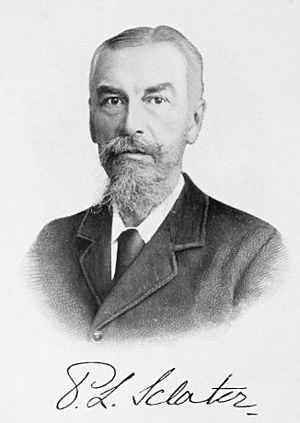Philip Sclater facts for kids
Quick facts for kids
Philip Lutley Sclater
|
|
|---|---|

Philip Lutley Sclater
|
|
| Born | 4 November 1829 Tangier Park, Wootton St Lawrence, Hampshire
|
| Died | 27 June 1913 (aged 83) Odiham, Hampshire
|
| Education | Winchester College |
| Alma mater | Corpus Christi College, Oxford |
| Occupation | Lawyer, zoologist |
| Children | William Lutley Sclater Jnr. |
| Parent(s) | William Lutley Sclater |
Philip Lutley Sclater (born November 4, 1829 – died June 27, 1913) was an English lawyer and a very important zoologist. A zoologist is a scientist who studies animals. Philip Sclater was especially good at studying birds, which is called ornithology. He also figured out the main animal regions of the world. For 42 years, from 1860 to 1902, he was the Secretary of the Zoological Society of London.
Contents
Philip Sclater's Early Life
Philip Sclater was born in a place called Tangier Park in Wootton St Lawrence, Hampshire. His father, William Lutley Sclater, owned a country house there. Philip had an older brother named George. Philip grew up at Hoddington House and became interested in birds when he was young.
He went to school at Twyford. When he was thirteen, he went to Winchester College. Later, he studied at Corpus Christi College, Oxford. There, he learned a lot about birds from a scientist named Hugh Edwin Strickland.
In 1851, Philip started studying law. He became a Fellow at Corpus Christi College. In 1856, he traveled to America. He visited Lake Superior and the St. Croix River. He even canoed down the river to the Mississippi! He wrote about this trip in a book called "Illustrated travels."
In Philadelphia, he met other scientists like Spencer Baird and John Cassin. After coming back to England, he worked as a lawyer for a few years. He also went to meetings of the Zoological Society of London.
What Did Philip Sclater Do?
In 1858, Philip Sclater wrote an important paper. In it, he described six main animal regions around the world. He called these regions the Palaearctic, Aethiopian, Indian, Australasian, Nearctic, and Neotropical. These animal regions are still used by scientists today!
He also came up with an idea in 1864 about a lost land called Lemuria. He thought this land could explain why some animals in Madagascar were similar to those in India.
In 1874, Philip became a private helper to his brother, George Sclater-Booth, who was a Member of Parliament. Philip was offered a permanent job in the government, but he said no. In 1875, he became the President of the Biology Section for the British Association for the Advancement of Science. He had been a member of this group since 1847. In 1873, he was also chosen to be a member of the American Philosophical Society.
Philip Sclater started and was the first editor of a journal called The Ibis. This journal is for the British Ornithologists' Union, a group that studies birds. He was also the Secretary of the Zoological Society of London for a very long time, from 1860 to 1902.
In 1901, he was the first Western scientist to describe the okapi. An okapi is a type of mammal that looks a bit like a zebra and a giraffe. Philip never saw a live okapi himself. His office in London became a popular meeting spot for all kinds of naturalists. Travelers and people living in London would share their notes with him. He also wrote letters to thousands of people around the world.
Philip had a huge collection of birds, about nine thousand of them! He gave this collection to the British Museum in 1886. Around the same time, the museum also got other large bird collections. This made the British Museum's bird collection the biggest in the world.
Philip Sclater wrote many important books. Some of them include Exotic Ornithology (1866–69) and Nomenclator Avium (1873), which he wrote with Osbert Salvin. He also wrote Argentine Ornithology (1888–89) with W.H. Hudson, and The Book of Antelopes (1894–1900) with Oldfield Thomas.
In June 1901, he received an special degree called a Doctorate of Science from the University of Oxford.
Philip Sclater's Family
On October 16, 1862, Philip Sclater married Jane Anne Eliza Hunter Blair. They had one daughter and four sons. Their oldest son, William Lutley Sclater, also became a scientist who studied birds. Their third son, Captain Guy Lutley Sclater, sadly died in 1914. He was 45 years old and died in an accident when the ship HMS Bulwark exploded. Philip Sclater is buried in Odiham Cemetery.
Animals Named After Philip Sclater
Many animals have been named after Philip Sclater to honor his work! Here are some of them:
- Sclater's lemur (Eulemur flavifrons)
- Dusky-billed parrotlet (Forpus modestus)
- Sclater's monal (Lopophorus sclateri)
- Erect-crested penguin (Eudyptes sclateri)
- Ecuadorian cacique (Cacicus sclateri)
- Mexican chickadee (Poecile sclateri)
- Bay-vented cotinga (Doliornis sclateri)
- Sclater's antwren (Myrmotherula sclateri)
- Sclater's lark (Spizocorys sclateri)
- Sclater's cassowary (Casuarius sclateri)
- Colombian longtail snake (Enuliophis sclateri)
Even though other famous scientists like Charles Darwin and Alfred Russel Wallace were very well known, Philip Sclater was a very important person in the study of biogeography. This is the study of where animals and plants live around the world. He helped us understand how different parts of the world are connected by the animals that live there.
Animals Named by Philip Sclater
Philip Sclater also gave names to some animals himself, including:
- L'Hoest's monkey
- Long-eared jerboa
- Okapi
Images for kids
See Also
 In Spanish: Philip Lutley Sclater para niños
In Spanish: Philip Lutley Sclater para niños


